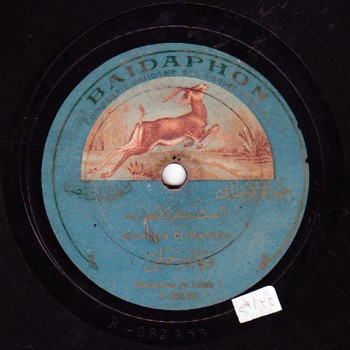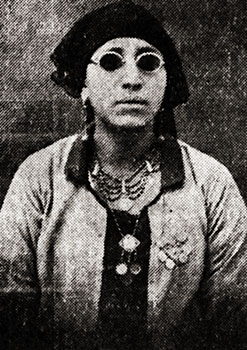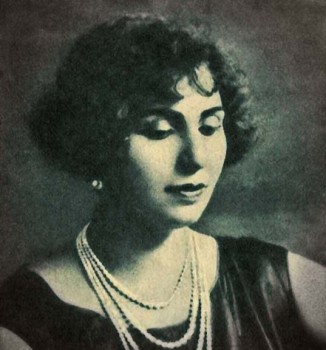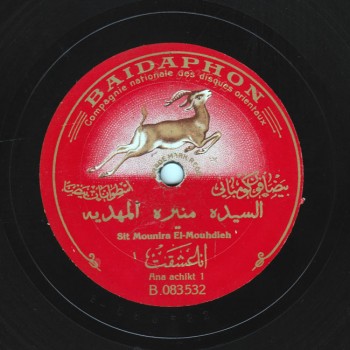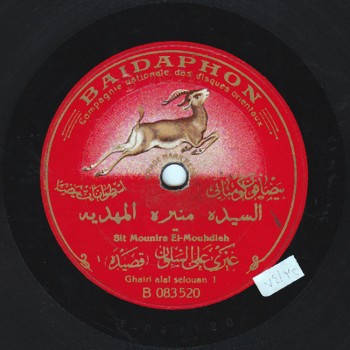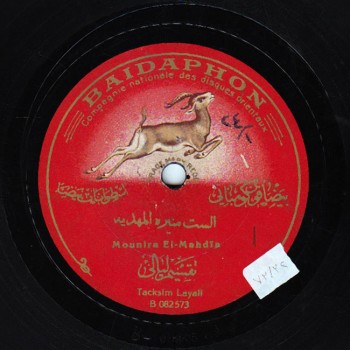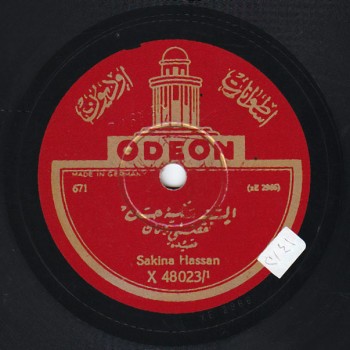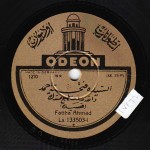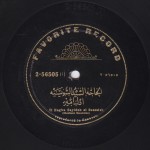The Arab Music Archiving and Research foundation (AMAR), in collaboration with the Sharjah Art Foundation (SAF), presents “Durūb al-Nagham”.
Welcome to a new episode of “Durūb al-Nagham”.
Today, we will resume our discussion about women who sang dawr. Prof. Frédéric Lagrange will explain the metaphorical aspect of dawr as we have already discussed taqāsīm layālī and mawwāl.
We have talked about the women who sang dawr before World War 1.
After that, it seems that most ‘ālima and particularly those who specialized in ṭaqṭūqa –either in their early form, i.e. the folkloric ṭaqṭūqa and the shared repertoire between Bilād al-Shām and Egypt including qadd and ṭaqṭūqa (of course the demarcation line between ṭaqṭūqa and qadd is abstract and blurred)– avoided all complicated forms such as the dawr. They attempted to perform qaṣīda metaphorically, which proved to be clumsy at best.
After World War 1, record production was the equivalent of the musicians’ religious leader, i.e. record companies were now governing music professions for commercial, social, political, and ideological reasons. Considering the necessity to reach a varied audience and to record a variety of forms, they either imposed or proposed, or this may have been a result of the evolution current. Thus, these women started recording these forms that used to be exclusively intended for men, including dawr.
One the one hand, the talented Asma al-Kumthariyya and Bamba al-‘awwāda were both capable of performing the “star of the concert” (the dawr –masculine word– was the male star of the concert).
On the other hand, other women –with no previous training or practice in the performance of such a form, invaded the male repertoire.
Let us compare those to Sitt Sakīna Ḥasan or Shaykha Sakīna Ḥasan –the Shaykha title did not appear in record catalogues, but if there was a Sheikh Yūsuf al-Manyalāwī, then she should be called metaphorically Shaykha Sakīna Ḥasan– a sober muṭriba who did not perform ṭaqṭūqa.
According to our information, she was blind and recited the Quran. Consequently, she deserves the Shaykha title. Moreover, her pronunciation proves she was educated and had learned the language correctly.
Exactly. This is also noticeable in her performance of qaṣīda “Taqaḍḍa zamān” that Sheikh Maḥmūd Ṣubḥ sang after her, maybe in the early 1930’s.
Let us listen to her great performance of qaṣīda “Taqaḍḍa zamān” then compare it to the performance of one of the most famous ‘ālima who became a muṭriba and decided to sing qaṣīda.
Let us start with Sakīna Ḥasan.
(♩)
The ‘ālima who became a muṭriba is the lady on whose stage the wind of freedom blew.
The air of liberty.
The air of liberty on Munīra al-Mahdiyya’s stage.
Here is Munīra al-Mahdiyya’s story:
Before World War 1, she was a modest ‘ālima who recorded more or less the same discs as Bahiyya al-Maḥallāwiyya, which makes one wonder whether she was the latter’s pupil.
After the war, she reappeared with a totally different profile. She was now “Sulṭānat al-ṭarab” –who had been the first Muslim Egyptian actress during World War 1–, and imitated Sheikh Salāma Ḥigāzī’s performance of tragic qaṣīda such as “Romeo and Juliet”, “Shuhadā’ al-Gharām”, or “Ṣalāḥ al-Dīn”. She recorded “Sall el-nugūm yā Charlotte” and “In kuntu fī al-jaysh”, as well as qaṣīda “Waylāhu mā ḥīlatī” also performed by adolescent singer Muḥammad ‘Abd al-Wahāb and taken from one of Salāma Ḥigāzī’s plays.
Let us listen to it in the voice of Munīra al-Mahdiyya.
(♩)
Comparing both Munīra al-Mahdiyya’s and Sakīna Ḥasan’s performance of this qaṣīda will prove difficult:
Sakīna Ḥasan performed it ‘ala al-waḥda while Munīra al-Mahdiyya, imitating Sheikh Salāma Ḥigāzī, performed it mursala.
So we will take their ability and their language as a criterion of comparison.
This will prove very difficult with Munīra al-Mahdiyya.
Even if we played an excerpt of Abū al-‘Ilā Muḥammad’s qaṣīda “Ghayrī ‘ala el-selwān qādir” performed by Munīra al-Mahdiyya and then compared it to Sakīna’s performance ‘ala al-waḥda… the difference if too big.
Let us listen to Munīra singing Sheikh Abū al-‘Ilā Muḥammad’s qaṣīda “Ghayrī ‘ala el-selwān qādir”, and note, once again, her imitation of one of the masters of singing.
(♩)
Munīra al-Mahdiyya decided to sing dawr, but she recorded very few compared to qaṣīda –this took place during the dawr’s last breath in the early 1920’s, right before it completely disappeared in the 1930’s– probably in order not to disgrace herself.
Let us listen to her performance of Sayyid Darwīsh’s dawr “Anā ‘ishi’t” to the ḥijāzkār, or to her performance of Dāwūd Ḥusnī’s dawr “Ashkī li-mīn dhull el-hawa” to the bayyātī.
What can we say about Munīra al-Mahdiyya’s performance of dawr?
…Difficult.
The word “difficult” may sum up what is heard in her performance… But what are the criteria to go by in order for this harsh judgement to be justified and fair?
First, the madhhab of “Anā ‘ishi’t” ’s ‘ala al-waḥda rhythm is not correct. Knowing that Sayyid Darwīsh built everything based on a sequence system, and that he insisted on the fixed features even more than Ibrāhīm al-Qabbānī or Dāwūd Ḥusnī, then going outside the waḥda was a bad choice: the madhhab can only be ‘ala al-waḥda.
Now concerning the tafrīd, she entered it into the henk, and into the waḥāyid… she did not follow any pattern concerning the dawr’s structure.
Also, she neither copied ‘Abd al-Ḥayy Ḥilmī’s habit of dropping some parts, nor did she know how to perform the tasallum and the taslīm with the biṭāna, or to deal correctly with the musicians as to the lāzima, from the first to the second in the henk or in the āhāt…etc.
(♩)
Dear listeners,
We have reached the end of today’s episode of “Durūb al-Nagham”
We will meet again in a new episode to resume our discussion about ‘ālima singing dawr.
We thank Prof. Frédéric Lagrange.
“Durūb al-Nagham”.
- 221 – Zakariyya Ahmed – 12 (1/9/2022)
- 220 – Zakariyya Ahmed – 11 (1/9/2022)
- 219 – Zakariyya Ahmed – 10 (11/25/2021)
- 218 – Zakariyya Ahmed – 9 (10/26/2021)
- 217 – Zakariyya Ahmed – 8 (9/24/2021)
- 216 – Zakariyya Ahmed – 7 (9/4/2021)
- 215 – Zakariyya Ahmed – 6 (8/28/2021)
- 214 – Zakariyya Ahmed – 5 (8/6/2021)
- 213 – Zakariyya Ahmed – 4 (6/26/2021)
- 212 – Zakariyya Ahmed – 3 (5/27/2021)
- 211 – Zakariyya Ahmed – 2 (5/1/2021)
- 210 – Zakariyya Ahmed – 1 (4/28/2021)
- 209 – W-al-Lāhi lā astaṭī‘u ṣaddak 2 (4/6/2017)
- 208 – W-al-Lāhi lā astaṭī‘u ṣaddak 1 (3/30/2017)
- 207 – Bashraf qarah baṭāq 7 (3/23/2017)

